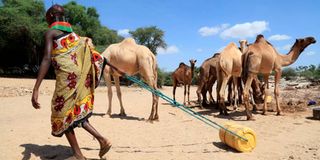Education bias fuels gender inequality

A young girl pulls a jerrican of water from a water point in Loima Turkana County on December 14, 2020.
What you need to know:
- The government has, for a long time, experienced difficulty in achieving its development goal in education.
- Due to poverty and sexual abuse, teenage pregnancy continues to widen the gender gap in education.
It is estimated that two-thirds of the illiterate adults are women. This is because, for many girls, completion of school is a problem regardless of the family’s wealth or the school’s location.
Unfortunately, very little is known about how education inequality affects gender equality, especially among adolescents. The government has, for a long time, experienced difficulty in achieving its development goal in education and ensuring all boys and girls, especially those in hard-to-reach areas, have access to quality education.
Kenya’s 2019 Violence Against Children (VAC) survey found out that 49 per cent of girls and 48 per cent of boys aged 13-17 years had suffered physical violence and 11 per cent of girls and four per cent of boys sexual violence.
Ministry of Education data show the gender gap in primary school is not as wide as in institutions of higher learning. Some 85 per cent of learners progress from primary to secondary school yet only 30 per cent proceed to tertiary institutions as women account for a third of the enrollment.
Girls’ education
This is often a result of inferior education, lack of opportunities, sexism, ignorance and cultural practices like female genital mutilation and child marriages.
Due to poverty and sexual abuse, teenage pregnancy continues to widen the gender gap in education as many girls drop out. In most communities, the girl-child is burdened by household chores and family responsibilities, which is considered as a rite of passage.
Gender-based violence in school also undermines girls’ education as it negatively affects their participation and school retention. Lack of sexual reproductive health and rights information is also an inhibitor to girls’ education.
The limited access to this information in school continues to disadvantage girls. Most girls, when they start having their periods, experience hygiene and sanitation difficulties like lack of sanitary towels and clean water and soap, forcing them to be absent from school or even drop out altogether.
Avoid stigma
Desperate to flow in dignity and avoid stigma, many are lured into sex in exchange for sanitary pads. Many are yet to benefit from the government-managed school free sanitary towel programme.
Adolescents in school engage in sexual activities with no proper information, which leads to teen pregnancy and transmission of HIV and other STIs with 99 per cent school drop-out among girls.
Achieving the national government agenda on equitable and good quality education requires a holistic approach in education for boys and girls alike. Having an inclusive approach that brings in all adolescents — including the most marginalised and vulnerable — under the umbrella of education will ensure that we achieve goals such as the 2030 education agenda.
The government must invest in SDG4, on education, so as to ensure inclusive and equitable education. That will help to promote lifelong opportunities for all, in line with SDG5, on gender equality.
Ms Odhiambo is the youth coordinator, Reproductive Health Network Kenya (RHNK). [email protected].





